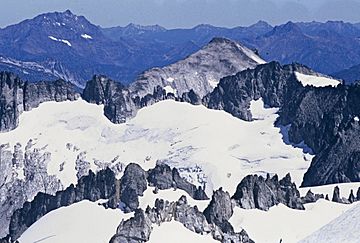Austera Peak facts for kids
Quick facts for kids Austera Peak |
|
|---|---|

Austera Peak, Austera Towers, McAllister Glacier
|
|
| Highest point | |
| Elevation | 8,339 ft (2,542 m) NAVD 88 |
| Prominence | 414 ft (126 m) |
| Geography | |
| Location | Skagit County, Washington, U.S. |
| Parent range | Cascade Range |
| Topo map | USGS Forbidden Peak |
Austera Peak is a tall mountain in North Cascades National Park in Washington, USA. It stands at 8,339 feet (2,542 m) (about 2542 meters) high. This peak is located in the southern part of the park. It is about 1 mi (1.6 km) north of Klawatti Peak. It is also the same distance south of Primus Peak.
Several large ice rivers, called glaciers, flow down from Austera Peak. These include the North Klawatti Glacier, the Klawatti Glacier, and the northern part of McAllister Glacier. Austera Peak is the highest point on a sharp, rocky ridge known as Austera Towers.
Weather at Austera Peak
Austera Peak is in a special climate zone called the marine west coast climate. This type of climate is found in western North America. Most of the weather systems start over the Pacific Ocean. They then travel northeast towards the Cascade Range.
When these weather systems reach the North Cascades, the tall mountains force the air upwards. This causes the air to cool down and drop its moisture. This moisture falls as rain or snow onto the Cascades. Because of this, the western side of the North Cascades gets a lot of rain and snow. This is especially true during the winter months.
The climate here is mild because it is close to the Pacific Ocean. Temperatures rarely go below 0 °F (−18 °C) (about -18°C) or above 80 °F (27 °C) (about 27°C). In winter, the weather is often cloudy. But in summer, high-pressure systems over the Pacific Ocean bring clear skies. The snow here tends to be wet and heavy. This can lead to a high risk of avalanches.
How Austera Peak Formed
The North Cascades mountains have very rugged land. You can see jagged peaks, sharp ridges, and deep valleys carved by glaciers. There are also tall, pointed rock formations made of granite. These amazing features were created by geological events that happened millions of years ago. These events caused big changes in the land.
The Cascade Range began forming millions of years ago. This was during a time called the late Eocene Epoch. The North American Plate (a huge piece of Earth's crust) was slowly moving over the Pacific Plate. This movement caused many volcanic eruptions. Also, small pieces of Earth's crust, called terranes, came together. This is how the North Cascades were formed about 50 million years ago.

Over two million years ago, during the Pleistocene period, glaciers grew and then melted many times. As they moved, these glaciers scraped and shaped the land. They left behind piles of rock and debris. The river valleys in the area have a "U" shape. This shape is a clear sign of recent glaciation.
The lifting of the land (called uplift) and cracks in the Earth's crust (called faulting) have worked with glaciation. These processes have created the tall peaks and deep valleys you see in the North Cascades today.




